Depleted uranium is the super weapon of the '90s; used in the Gulf War and the conflict in Kosovo. But
now Canadian troops, soldiers and peacekeepers alike, may be exposed to depleted uranium with its potential danger. Now this
threat wasn't one raised by a hostile enemy, but by the arms used by the United States and other NATO allies. They defeated
the toughest armoured vehicles with the use of depleted uranium. It packed a knockout punch, but what soldiers often didn't
know was that depleted uranium poses a threat to victor as well as vanquished. Dan
Bjarnason reports this cautionary tale. The story producer was Marijka Hurko.
Jerry Wheat went off to war in the Gulf, He drove a Bradley armoured personnel carrier for the Third
armoured Division. Then the war followed Jerry home to New Mexico.
"I have had real bad joint pain, abdominal problems," Wheat says. "I get real bad
headaches. I went from 220 pounds down to 160 pounds for no reason, and that's when I started suspecting that it was something
related to the Gulf."
 The shadows of that
war eight years ago still haunt him. Wheat brought back more than victory from the front. Awarded a Purple Heart after being
wounded in combat, Wheat came home with pieces of shrapnel embedded in his body and with mysterious body pains. Jerry Wheat is
convinced these ominous souvenirs from the firing line are connected. The shadows of that
war eight years ago still haunt him. Wheat brought back more than victory from the front. Awarded a Purple Heart after being
wounded in combat, Wheat came home with pieces of shrapnel embedded in his body and with mysterious body pains. Jerry Wheat is
convinced these ominous souvenirs from the firing line are connected.
The ground campaign in the Gulf War involved much fighting by armoured forces. Wheat's unit was in the
thick of it, and his vehicle was accidentally hit twice by fire from his own side. What Wheat did not know was that the shells
that hit him were made from depleted uranium, the pride of the American arsenal.
"It blew off my helmet and blew me into the front of the vehicle," Wheat recalls. "I
could feel it. I could feel the burning because when the rounds went through, the aluminum melted. And as it goes in you, just
burns; it cauterizes as it goes in. At that point, I felt the shrapnel hit me in the back -- hit me in the back of the head. I
had second and third degree burns on the back of my head."
It's the new wonder weapon the Pentagon calls a "silver bullet."
|
What is depleted uranium? |
Depleted uranium is still uranium. There are three types of uranium, U238, U234 and U235.
Uranium 234 and 235 are fissionable material, the kind used in bombs. Depleted uranium is what is left over when the
U234 and U235 is removed. The remaining U238 is still highly radioactive.
|
|
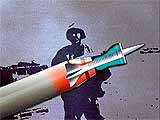
Depleted uranium shell
|
A DU round is made from the leftover U238. The killing punch comes from the solid depleted
uranium metal rod in the shell. A 120 mm tank round contains about 4000 grams or 10 pounds of solid DU. |
|
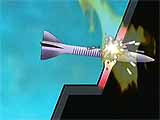
DU shell hits
|
A DU rod is very dense. At high speed, it slices through tanks like a hot knife through
butter. It burns on impact, creating flying bits and dust that are toxic and radioactive with a half-life of 4.2
billion years. |
In the Gulf War, the U.S. fired almost a million DU rounds, leaving a battlefield littered with 1,400
wrecked radioactive Iraqi tanks, crawled over by victorious GI's who were breathing in contaminated dust.
Jerry Wheat and the other Gulf vets were never told of the risks of being exposed to a DU campaign. But
after the shooting stopped and back home in Los Lunas, New Mexico, Wheat -- now out of the army -- grew mystified as his
health deteriorated. Military doctors had no answers.
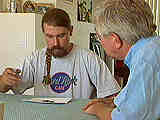 Then a
year after war's end, Wheat got startling evidence from his father -- a technician at the famous Los Alamos Nuclear Research
Centre, who just out of curiosity tested the shrapnel that came from his son's body and gear. The shrapnel was radioactive.
Today, eight years after the Gulf War, that shrapnel still lights up a Geiger counter. He also keeps other pieces. Then a
year after war's end, Wheat got startling evidence from his father -- a technician at the famous Los Alamos Nuclear Research
Centre, who just out of curiosity tested the shrapnel that came from his son's body and gear. The shrapnel was radioactive.
Today, eight years after the Gulf War, that shrapnel still lights up a Geiger counter. He also keeps other pieces.
"This is shrapnel out of my gear. And there was just a couple pieces that I took out of my body --
a couple small pieces… I kept it since I found out the vehicle was hit with a DU penetrator, I just kept it so I would have
it. Just kind of proof," Wheat says.
The pieces on the table are not a danger, he says. "But if you actually got a piece that was
depleted uranium and you had inhaled it or swallowed it or something, then you would have a potential heavy metal
problem," Wheat says.
Jerry's great fear is that whatever he brought back with him from the Gulf is now afflicting his family.
His older son Joe was hospitalized with breathing problems the day after Wheat dragged his contaminated gear into the house.
Derrick, his youngest son, who was born after the war, suffers strange blisters on his hands. His wife suffered a miscarriage.
Jerry himself recently had a tumour removed from his shoulder. He now worries continually about cancer.
Jerry says the military has never shown any interest in his shrapnel. The military said Jerry's health
problems are due to post traumatic stress.
At the Pentagon, depleted uranium is no mystery weapon. The American military has been testing it for 40
years, yet no one in the corridors of power gave much attention to ensuring that American GI's knew how to handle the new
weapons system. Bernard Rostker is the under secretary of the army, and he admits that over the years, troops were given no
proper training. Rostker himself reported in 1998 that American soldiers in their thousands had been unnecessarily exposed to
DU; this seven years after the end of the Gulf War, when it was first used.
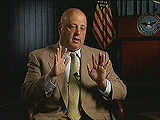 "We were not
diligent in training our troops," Rostker says. "That doesn't mean that there were any health consequences. These
are men who survived friendly fire incidences and have been traumatized; some had been burned, some have lost limbs. So they
are not without health problems. But those health problems are not attributable to the heavy metal toxicity or the
radioactivity of depleted uranium." "We were not
diligent in training our troops," Rostker says. "That doesn't mean that there were any health consequences. These
are men who survived friendly fire incidences and have been traumatized; some had been burned, some have lost limbs. So they
are not without health problems. But those health problems are not attributable to the heavy metal toxicity or the
radioactivity of depleted uranium."
"So what do you tell the vets who are ailing from something and they feel it's because of depleted
uranium weapons?" reporter Dan Bjarnson asks.
"We, first of all, don't believe that this is people's imagination. We think people are ill. We
have an extensive program trying to understand what they may have been exposed to on the battlefield. We have published over
23 reports. Unfortunately, we have not found a smoking gun."
The number of Gulf War vets who were in contact with radioactive tanks or breathed in contaminated dust
could be in the tens of thousands. Yet so far, only a fraction -- about 200 vets, like Jerry Wheat -- are being monitored. The
Pentagon still insists there is not enough evidence to link exposure with illness.
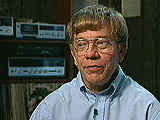 Doug Rokke is a
thorn in the side of the military today because of what he learned eight years ago in the Gulf, where he served as lieutenant
with the U.S. Army Preventitive Medicine Command. There he led army teams that cleaned up contaminated vehicles hit by DU
rounds. Now he is collecting evidence that the Pentagon knew of the health hazards to himself and other vets all along. He now
teaches at Jackson State University in Alabama. Doug Rokke is a
thorn in the side of the military today because of what he learned eight years ago in the Gulf, where he served as lieutenant
with the U.S. Army Preventitive Medicine Command. There he led army teams that cleaned up contaminated vehicles hit by DU
rounds. Now he is collecting evidence that the Pentagon knew of the health hazards to himself and other vets all along. He now
teaches at Jackson State University in Alabama.
"It's obvious today that the military did know, but they didn't inform anybody," Rokke says.
"There were two memorandums that came to us in March of 1991 as we started the cleanup of the contaminated equipment and
the casualties in the Gulf. One memo was known as the Los Alamos memorandum."
The Los Alamos memo, written by a
Lt.Col. M. V. Ziehmn read, in part, "there has been and continues to be a concern regarding the impact of DU on the
environment. Therefore, if no one makes a case for the effectiveness of DU on the battlefield, DU rounds may become
politically unacceptable and thus, be deleted from the arsenal. ...Keep this sensitive issue in mind when after action reports
are written."
"The Los Alamos memorandum specifically gave us guidance that said when we are writing a report, or
reporting our findings, make sure -- make sure that we don't disrupt the future use of depleted uranium munitions," Rokke
says.
Then a second memo, from the Defence
Nuclear Agency, arrived about the same time. It read "Alpha particles (uranium oxide dust) from expended rounds is a
health concern but, Beta particles from fragments and intact rounds is a serious health threat..."
"The two memos, added together now after eight years of thought and research and discussions now,
in my mind, are very clear. The United States and the world know about the health and the environmental consequences of using
this munition and they don't care," Rokke says.
We asked Roskter, if there is no DU problem, why these warnings about DU hazards issued as far back as
1991?
"There has been concern all along with every weapon," Roster says, "We have done testing
on depleted uranium, from the beginning, to determine whether it is of particular concern."
After the Gulf War, Doug Rokke was assigned to produce a Pentagon training video to teach soldiers how
to handle depleted uranium. It was a video that was ultimately shelved and never shown to the troops.
"There are four general situations during which depleted uranium may present hazards to soldiers.
One: if the equipment is damaged or destroyed in combat or in an accident," the video says.
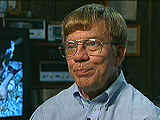 "This is part of the training video that
we finished in 1995," Rokke says. "The important part here, what we learned from our research, is everybody involved
in working with depleted uranium contaminated equipment must wear respiratory protection and they must have some kind of
coveralls or covering that can protect their clothes. What we learned, is you can't get this off the clothing." "This is part of the training video that
we finished in 1995," Rokke says. "The important part here, what we learned from our research, is everybody involved
in working with depleted uranium contaminated equipment must wear respiratory protection and they must have some kind of
coveralls or covering that can protect their clothes. What we learned, is you can't get this off the clothing."
"In the Gulf, we basically just had dust masks. We were told that the dust masks and the surgical
masks would work and we could wear gloves. And all we had was the uniforms that we had available."
"And they knew no better; no one had ever hinted to them they were in peril?" Bjarnason asked.
"And that's criminal," Rokke replies.
The CBC showed that training video to Bernard Rostker at the Pentagon.
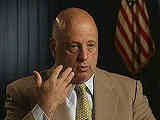 "Very
interesting film, because you notice something that has been very confusing to some of the troops. Some of them were in full
mop gear -- chemical protective gear and a gas mask. But they show other soldiers who were in a bandanna. In fact what you
really need is a dust respirator and that's to meet the standards of the EPA. That does not mean anybody who didn't meet the
standards during the Gulf War have levels of depleted uranium were likely to be impacted permanently." "Very
interesting film, because you notice something that has been very confusing to some of the troops. Some of them were in full
mop gear -- chemical protective gear and a gas mask. But they show other soldiers who were in a bandanna. In fact what you
really need is a dust respirator and that's to meet the standards of the EPA. That does not mean anybody who didn't meet the
standards during the Gulf War have levels of depleted uranium were likely to be impacted permanently."
The Pentagon built a high security, high priced, high tech cocoon at the Savannah River nuclear facility
in Georgia to process radioactive materials from contaminated equipment. It has special walls and flooring to prevent any air
or dust from escaping into the outside world. It's known as Building 101.
"If they're going to spend millions and millions of dollars to clean up the contaminated equipment
that's come back from the Gulf, which you have seen here, then how could they say there is no hazard?" Rokke asks.
"Look at the amount of effort we do to take asbestos out of a building or lead paint. That doesn't
mean that if you walk past a window that has had lead paint that you're going to immediately get lead paint poisoning,"
Rostker counters.
Doug Rokke's experiences in the Gulf ended eight years ago, but he still fights his battles with the
Pentagon from his home in Jacksonville, Alabama. He is convinced his health started to slip away because of his work among
contaminated vehicles over there in the deserts of Iraq and Kuwait.
"The problems that I have are breathing problems. My lungs have scar tissue in them. When I run or
exercise, there are secretions -- fluids just fill up in the lungs. I don't have the fine motor control to do all the fine
things that I used to be able to do because the nerves don't work like they should. Eye problems, vision problems, kidney
problems," Rokke says.
Rokke has one important ally in his fight with the Pentagon. He is Dr. Jack Zerimba, head of the Gulf
War Clinic at a U.S. Veteran's affairs clinic in Birmingham, Alabama.
He studied Rokke's breathing problems and the scar tissue on his lungs and says, "That is
consistent with uranium exposure and other things too, such as metal exposure."
This official affirmation of a link is for Doug Rokke, his biggest victory in eight years.
In Washington, the Gulf War vets have enlisted the attention of many politicians. Wisconsin Democrat
Senator Russ Finegold pressed for and got an investigation by the high powered and independent General Accounting Office, the
investigative arm of Congress.
"The evidence is contradictory with regard to the connection between depleted uranium and the many
soldiers from the Gulf War who are complaining of ill effects," Finegold says. "Some reports indicate a real problem
here; others question it. I think we need an independent investigation to determine whether this is really true. We have been
through this before with many years of denial with regard to Agent Orange and its use in Vietnam. I don't want to see our
government in any way, in fact or in perception, stonewall this issue of the health effects of depleted uranium.
In the latest chapter of this revolutionary new weapons system, DU ammunition was fired in this spring's
NATO war in Yugoslavia. As usage becomes more frequent, for Finegold, the need for answers becomes more urgent.
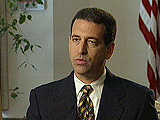 "Keep in
mind that depleted uranium was used recently in Kosovo and may well have effected people there as well," Finegold says,
"This is not just old news. It is real current news for those who are ill from the Gulf War. And we may be finding other
people, from the Kosovo conflict, who will experience similar problems in the future because of depleted uranium." "Keep in
mind that depleted uranium was used recently in Kosovo and may well have effected people there as well," Finegold says,
"This is not just old news. It is real current news for those who are ill from the Gulf War. And we may be finding other
people, from the Kosovo conflict, who will experience similar problems in the future because of depleted uranium."
Canada once had depleted uranium in its inventory shells for the Navy during the Gulf War, but they were
never fired and are now being disposed of because of the expense of special handling and storage facilities.
But Canadian troops must still deal with DU in Kosovo. Some 1,400 soldiers are now on patrol as part of
a NATO peacekeeping contingent. They're equipped with small radiation detection devices and they're also under orders to stay
away from any damaged Serb vehicles they come across; vehicles that may have been contaminated by DU ammunition fired by
American planes last Spring during the air offensive.
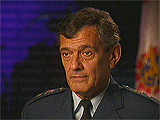 At Defence
headquarters in Ottawa, Brig.-Gen. David Jerkowski is in charge of all the operations of all Canadian troops overseas; their
supplies and movement and safety. At Defence
headquarters in Ottawa, Brig.-Gen. David Jerkowski is in charge of all the operations of all Canadian troops overseas; their
supplies and movement and safety.
"Our soldiers are not at risk," Jerkowski says. "There are other risks that are much
greater than depleted uranium: there are many many more threats out there: landmines, diseases, reptiles. It depends on where
we work in the world, and there are many greater risks than that."
A Canadian Forces routine order refers to "the inhalation of radioactive material as a primary
health hazard."
"It depends on who wrote that particular order," Jerkowski says. "They are making sure
that our troops are going to heed this and stay away from tank hulks, for example."
But U.S. Army Reserve Maj. Doug Rokke, who once ran the DU Project for the Pentagon, insists that an
order simply to stay away from damaged vehicles is far from enough.
"Just staying away from it is only part of an answer, because unless the contamination is
completely removed from all areas, how are you going to avoid it? How do you avoid it on a battlefield that's littered with
uranium?"
Thousands of returning refugees are now fanning out across Kosovo, through a countryside strewn with
rubble and war wreckage. No one has the particular task of keeping them clear of high-risk areas. U.N. environmental teams are
running tests to check for signs of contamination; they need maps indicating where NATO DU hits were made. The Pentagon has
not obliged.
"I don't think it's necessary and I don't know whether they could, even with any rigour, be
created," Rostker says. " I mean the targets were combat vehicles and I'm not sure the pilots would have known where
they were. The best thing you could find is the destroyed vehicle and I don't know of any that have been reported."
The stockpiling of DU weapons is spreading. As depleted uranium is becoming more, not less popular with
the world's generals, more than 20 countries now have DU In their arsenals. If the lessons from past eras are anything to go
by, there is often great ignorance about the path being charted when new weapons come along. For example when atomic testing
was all the rage in the '50s, or when Agent Orange was used in Vietnam. When revolutionary new technology is introduced on the
battlefield, no one at the time has any real idea of the consequences.
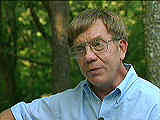 "The next time we
go to war, the enemy may fire uranium at us," Rokke says. "So whether or not we decide to have it or not, or decide
to use it or not, somebody else may decide to use it. We need to make sure that everybody knows what medical care to provide
and how to complete the environmental cleanup. Everybody needs to know." "The next time we
go to war, the enemy may fire uranium at us," Rokke says. "So whether or not we decide to have it or not, or decide
to use it or not, somebody else may decide to use it. We need to make sure that everybody knows what medical care to provide
and how to complete the environmental cleanup. Everybody needs to know."
The military predict that depleted uranium will shape the battlefields of the future, but the future is
already here.
"Silver Bullet" published by the Canadian Broadcasting Corporation and is Copyright
© 2000 CBC All Rights Reserved.
Home | Top
|